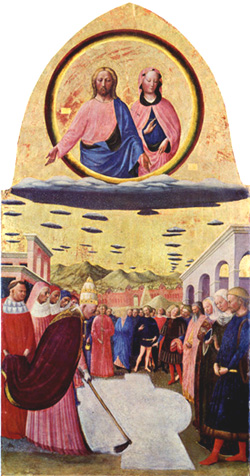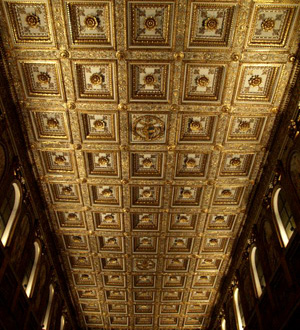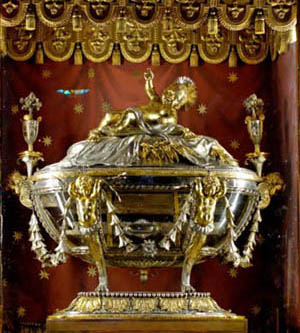 |
Feast Days of Our Lady
Our Lady of the Snow - August 5
Prof. Plinio Corrêa de Oliveira
Biographical selection:
The feast day of Our Lady of the Snow is also the day of the dedication of the Basilica of Santa Maria of the Snows, or Santa Maria Maggiore [Saint Mary Major] in Rome.
Since the 7th century it was known also as Maria ad Præsepe because the Basilica has some pieces of wood from the Manger in which Our Lord was born. The ceiling of the Basilica is gilded with the first gold that came from the Americas.

Pope Liberius defines in the snow the future site of Santa Maria Maggiore
Masolino da Panicale, c. 1400
|
This was the first church in Rome to be dedicated to Our Lady. In the 4th century Pope Liberius added a lateral hall to a large existing hall of a Roman patrician palace and dedicated it to the cult; for this reason it was called the Basilica Liberii [Liberian Basilica]. Pope Sixtus III (432-440) restored it almost a century later and dedicated it to the Virgin, who the Council of Ephesus had defined as Theotokos, that is, the Mother of God. It was then that the Basilica received the name of Santa Maria Maggiore, Santa Maria Mayor.
A beautiful legend tells us that Our Lady appeared in dreams simultaneously to Pope Liberius and to the Roman patrician who owned the property where the church would be erected. She commanded the Pope to build a basilica on Esquiline Hill on the site that would be covered with snow the next day. Indeed, during that night of August 4-5, 352, in the very heat of the summer, a miraculous snow fell on the summit of the Hill, indicating the place for the church to be built. This is why this basilica is also called Our Lady of the Snow.
The patrician had a similar dream indicating that he should donate the palace and land for the church to be built. Our Lady also told him that she would send the snow as a sign.
To commemorate the Miracle of the Snow, every August 5th a cascade of white petals descends from the coffered ceiling onto the altar place during the religious festivities.
It was in this church that one Christmas night Our Lady placed the Divine Infant into the arms of St. Cajetan of Thiene. It was here on another Christmas night that St. Ignatius of Loyola celebrated his first Mass. In this church, St. Pius V prayed the Rosary that obtained for the Catholic warriors the victory of Lepanto. There is a chapel in the Basilica that has a picture of Our Lady that, according to tradition, was painted by St. Luke. St. Charles Borromeo used to pray often in front of this Madonna, and in testimony of his gratitude to her, he wrote the Rule of the Canons of Santa Maria Maggiore.
Comments of Prof. Plinio:
Here you can see the beautiful role of legends. Synarchic (1) or technocratic minds do not like legends because they lack definite proof of truth. They do not understand that the legend exists to prove something superior to the concrete fact. In this story, for example, we find many things that tell us about Our Lady.

The ceiling of the Basilica is gilded with the first gold from the Americas
|
It can be disputed whether or not the snow actually fell on that day in August, but the legend reminds us that Our Lady has the power to transcend the laws of nature. There is an enormous distance between Heaven and earth. She can make nothing of this distance and appear to a Pope. Naturally speaking, it is marvelous for it to snow in the hot summer - July and August are terribly hot months in Rome - but she has the power to make this happen if she so desires.
Morally speaking, we experience this truth whenever she sends us consolations in the most heated hours of our battles, trials and sufferings. At such moments, she lets fall on us an immaculate, white and refreshing snow that gives us a pre-taste of Heaven. Therefore, even though someone can dispute the veracity of the legend of the snow that fell, he cannot dispute that Our Lady is able to make this miracle if she desires, and that in fact she does so frequently in a moral sense. This is the superior truth the legend contains.
Surrounding this basilica is an atmosphere permeated with History. You can find many magnificent things there: wood from the Manger where Our Lord was born in Bethlehem, the famous icon of the Virgin Mary said to be painted by St. Luke known as Salus Populi Romani [the salvation of the Roman people], and the basilica's ceiling gilded with gold from the mines of America and presented by the Sovereigns of Spain, Ferdinand and Isabella, to the Pope. It is a very beautiful gesture to take the first gold from America and, instead of putting it in a bank vault, offer it to the Church so it can be “uselessly” placed on the ceiling of a church dedicated to Our Lady. To send the first riches, the first fruits of America, and use it to honor Our Lady is an implicit recognition that she is the Mediatrix of all Graces.

The sacra culla, the sacred crib that holds the wood of Our Lord's Manger
|
Also, the excerpt duly recalls that incident when St. Pius V was in Santa Maria Maggiore meeting with some cardinals and he stopped to pray the Rosary. During it he had a revelation that the Catholics had won the Battle of Lepanto. I don’t know why the selection doesn’t mention that the body of this holy Pope is buried there. Whoever visits the Basilica can venerate the body of that General Inquisitor and great enemy of Protestants and Muslims, as I had the grace to do.
The impressive parade of Saints and many important relics present there are testimony to the Catholic tradition that lives in Santa Maria Maggiore. In that monument one finds many traces of great historical events - one of them the Incarnation of the Divine Word itself. All this reveals the splendor of tradition in Catholic Civilization.
This feast day tells us of the importance of both tradition and the legend.
Let us pray to Our Lady that under this very poetic invocation of Our Lady of the Snow, she will help us to love and fight for the sacred traditions of the Church and open our souls to the most astonishing miracles during the days of the chastisement predicted at Fatima.
1. Synarchie or synarchia - a secret society whose goal is to control the technological growth in the world and its financial consequences. The term is habitually used to refer to the Masonic control of technology, or simply as synonymous with the technocratic mentality, as in this comment of Prof. Plinio. For more on the topic in French, click here and here.


  | | Prof. Plinio Corrêa de Oliveira | |
The Saint of the Day features highlights from the lives of saints based on comments made by the late Prof. Plinio Corrêa de Oliveira. Following the example of St. John Bosco who used to make similar talks for the boys of his College, each evening it was Prof. Plinio’s custom to make a short commentary on the lives of the next day’s saint in a meeting for youth in order to encourage them in the practice of virtue and love for the Catholic Church. TIA thought that its readers could profit from these valuable commentaries.
The texts of both the biographical data and the comments come from personal notes taken by Atila S. Guimarães from 1964 to 1995. Given the fact that the source is a personal notebook, it is possible that at times the biographic notes transcribed here will not rigorously follow the original text read by Prof. Plinio. The commentaries have also been adapted and translated for TIA’s site.
|
Saint of the Day | Home | Books | CDs | Search | Contact Us | Donate

© 2002- Tradition in Action, Inc. All Rights Reserved
|
 |

|